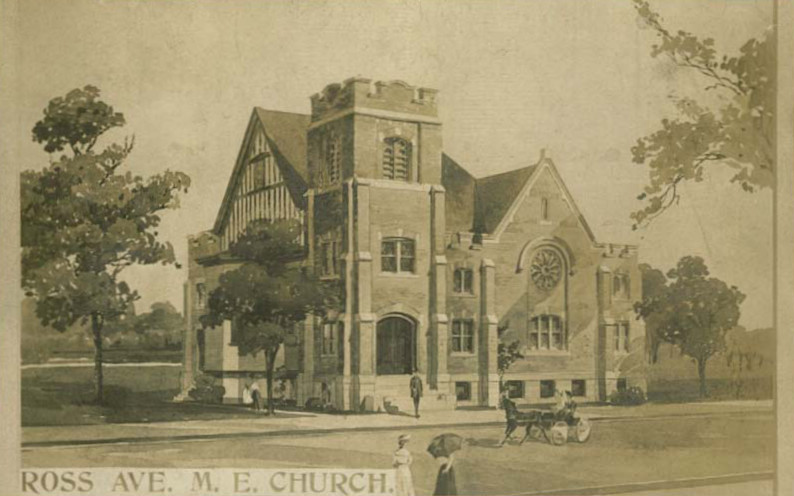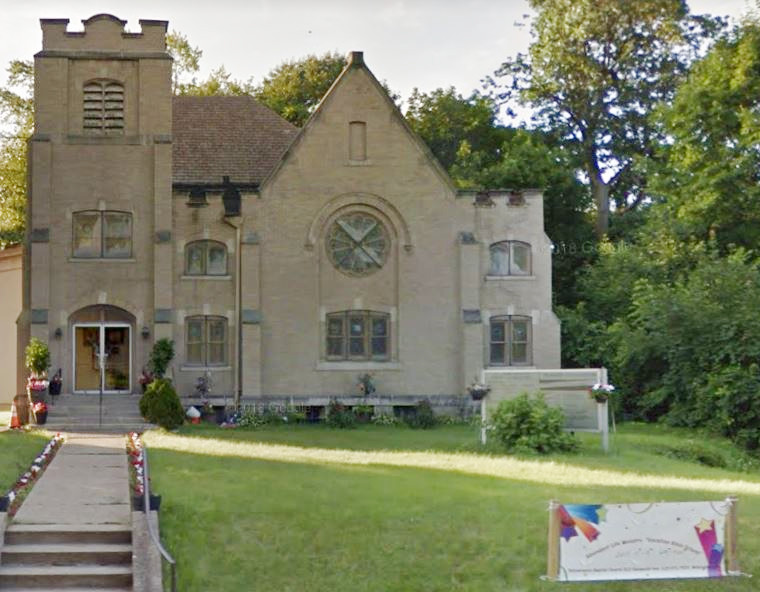
Josephine Gallaher wrote in 1981 for seventy-fifth anniversary of the Ross Avenue Church,
The Ross Avenue Methodist Episcopal Church was organized by a number of members of the South Avenue Methodist Episcopal Church who felt the need for a Methodist Church in the eastern end of town. It was also necessary because South Avenue was not big enough to hold all its members. The South Avenue Church purchased the lot at the corner of Ross and Swissvale Avenues at the cost of $7000.
At the Annual Conference in October, 1905, the Rev. R. M. Fowles was assigned as the church’s first pastor. The church was formally organized on October 30, 1905 in a classroom at South Avenue Church with about 275 members. From that date to April 22, 1906, while the church was being built, the congregation worshipped Sunday afternoons in the South Avenue Church.
The original church lot—fronting sixty-six feet on Ross Avenue and one hundred thirty feet on Swissvale Avenue was purchased November 16, 1905. As originally located and built, the church building had serious shortcomings . . . happily, these were corrected by later developments. Lacking adequate space, the builders crowded a 65-foot structure onto a 66-foot lot. Access to the church was up a steep flight of steps which extended upon the street side-walk area—an illegal obstruction—and through a doorway with doors swinging inward, creating an illegal and inexcusable hazard. Separated from street pavement only by the width of a narrow sidewalk, the vibration arising from nearby traffic was most disturbing. The basement was excavated only enough to provide space for furnace and coal storage. In 1920 the men of the church contributed the labor necessary to excavate and improve the entire basement area.
There was a double frame house on the corner of the lot facing Ross Avenue. Ma and Pa Hewitt (the church custodians) lived in one unit and the other part was rented. This was all the property the church owned at that time.
In 1912, the church purchased the adjoining lot, fronting thirty-three feet on Ross Avenue and including a frame house. This became the first parsonage, and was first occupied as such by the incoming pastor, Rev. N. H. Sanner.
Under the stimulation of aid promised by the Centenary Movement for the building of a new auditorium, the church made a vigorous campaign for the Centenary in 1920, and gave its loyal support thereafter. Preliminary conferences had under consideration a very substantial award for Ross Avenue, but the original amount was scaled down to a definitive award of $20,000 at the time of actual canvass.
It was essential to have more space for the planned construction, and in 1921, two more adjoining lots were purchased, each lot having a frontage of thirty-three feet on Ross Avenue. On the first lot, there stood a buff brick house which for a brief time was used as the second parsonage. The lot between the house and the parsonage was vacant.
The widening of Swissvale Avenue in 1927 appropriated a twenty-foot strip of church property and made it necessary to move the church to its present location. To compensate for loss of building area and still retain a parsonage adjoining the church site, the property now used as the present parsonage was purchased on April 1, 1927. About this time, it was decided to remove the double frame house on the corner. The church building was moved in 1928.
The inability of Centenary officials to pay the promised award was a discouraging experience. This was followed shortly by the period of depression.
Shrinking receipts made it necessary to omit all tax payments for two years in order to avoid defaulting payment of interest on mortgages. By the end of 1935 the combined debt reached a peak of $20,000, a critical time in the history of the church. Fortunately, the decision was to begin an attack upon the indebtedness. The burning of the mortgage, January 5, 1947, was a time of rejoicing. At that time the mortgage had been satisfied, some repairs made, and a new pipe organ was near at hand.
A thrilling and joyful time arrived in 1948 when the dedication of a new pipe organ and chimes became a reality. The congregation has enjoyed many years of beautiful music. Many dedicated organists, choir directors and choirs have come and gone after having shared their talents with our church.
On June 17, 1965, James Street Methodist Church merged with Ross Avenue to form our present congregation. It was a smooth and successful transition for both churches.
Upon the merger of the Methodist and the Evangelical United Brethren churches in 1968, our church had a name change to Ross Avenue United Methodist Church.
During the late 1970’s, the social room received a new dropped ceiling and paint. For the anniversary celebration the exterior of the church buildings was painted. A new church sign was dedicated on Sunday, April 26, 1981. It was decided that the buff brick and old frame houses should both be removed to make way for a parking lot.
Down through the years, many organized women’s groups served the church faithfully the Ladies Aid Society, Home Missionary Society, Foreign Missionary Society and Young Women’s Missionary Society which all combined to become the Woman’s Society of Christian Service and later to be known as the United Methodist Women. They have supported the church fInancially as well as spiritually in its many projects and endeavors.
Many adult Sunday School Classes have been active throughout our church history— Victoria Class, Kunkle Class, Win One Class, Peg-A-Way Class, Lincoln Bible Class, Young Men’s Bible Class, Golden Rule Class, Sunshine Class, Young Adult (Christian Guild) Class, Young-At-Hearts Class. They all have given their time and talents for the benefit of others while meeting each Sunday to read and study about our Lord.
Many wonderful years have gone by for Ross Avenue United Methodist Church. It has been a sound foundation for our lives. God has blest each of us in that we have been happy in His work and our fellowship here.
In 1989 the Ross Avenue United Methodist Church merged with South Avenue United Methodist Church.
Deliverance Baptist Church bought the building on April 23, 1991. Bishop Michael W. Golphon Sr. became pastor of Deliverance in July 1996. This is a congregation with a sense of joy and a feeling for the beauty of flowers.

Wilkinsburg Public Library Digital Archives:
Josephine Gallaher, church historian, “Historical Sketch” in Ross Avenue United Methodist Church, 1906–1981, 75th Anniversary publication.